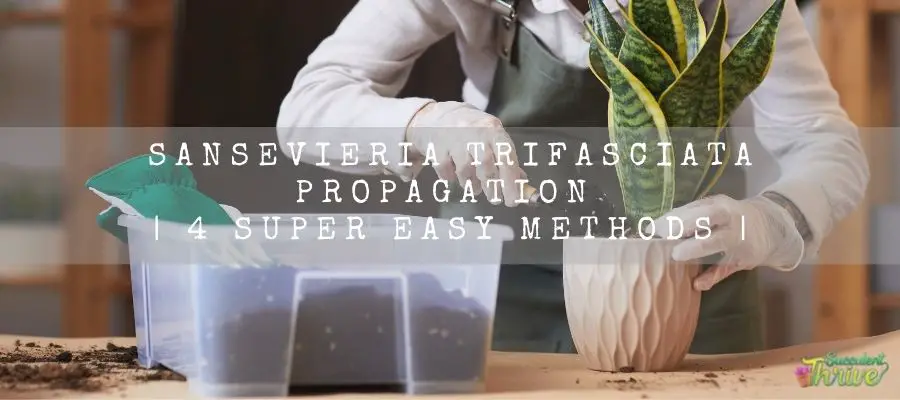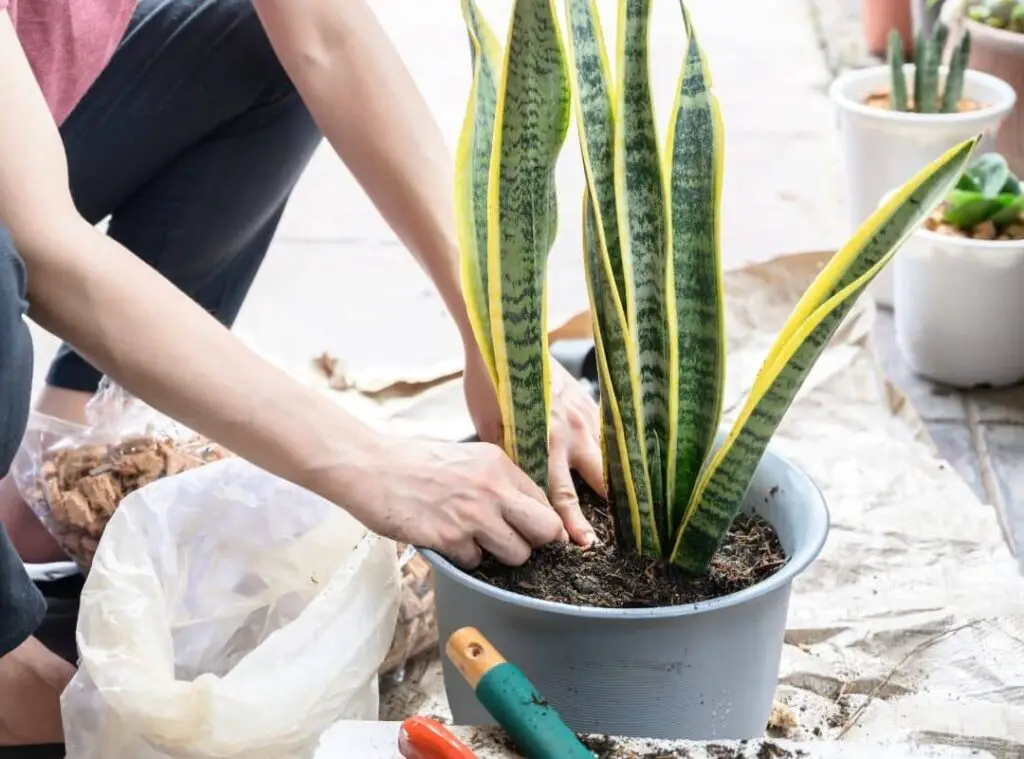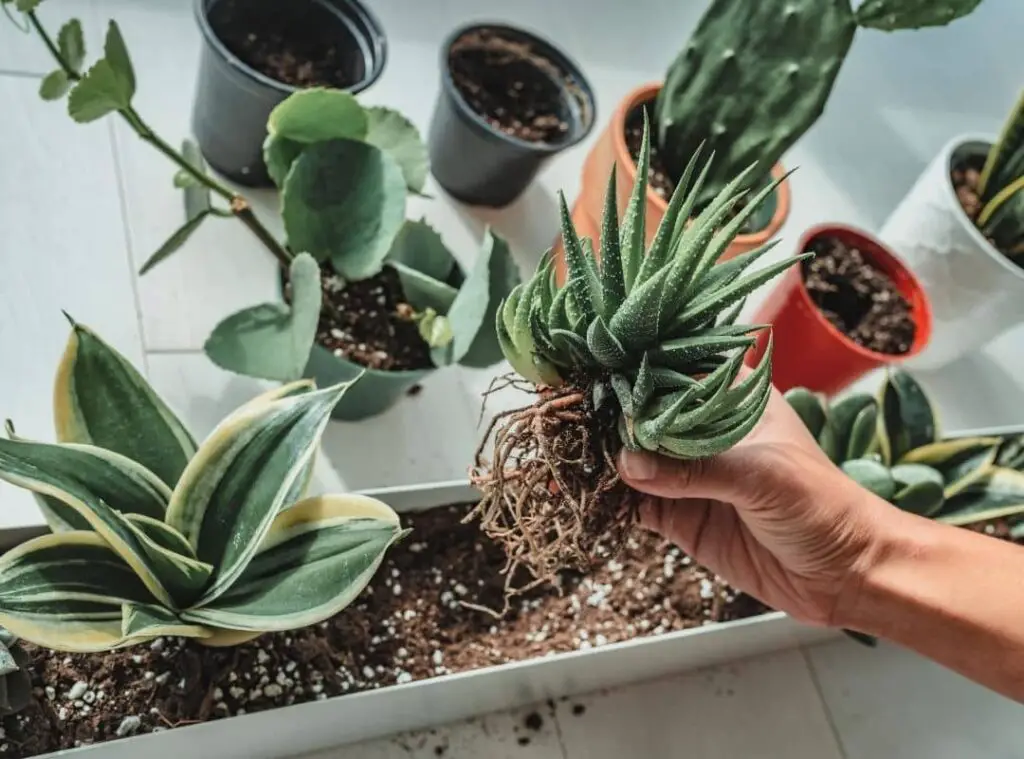If you are into succulent gardening, I am sure you would be happy to learn about Sansevieria trifasciata Propagation. It is a pretty easy job than you think.
Sansevieria Trifasciata or snake plant is one of the famous succulent varieties you would come across. They are such a pretty and versatile set of plants which would grace wherever you locate them.
Furthermore, they are easy to grow plants and many people tend to grow them due to that reason as well.
If you are willing to add more and more snake plant varieties, you do not have to go to the store and purchase new plants. Instead, you could simply use the propagation method and try to make new plants. It is a quite easy process to follow.
As such, if you are interested in exploring this, this is the article you need to go through as we are going to talk about the methods of propagating them in detail.

Sansevieria trifasciata propagation in water
It is a very easy process to root Sansevieria Trifasciata in water. You simply have to do as follows.
- First you need to select a leaf which is healthy enough. Refrain in selecting an older leaf. Ideally you need to take a few cuttings to proceed.
- Secondly you could cut off the leaf. To do this, you could use sharp and sterilized scissors. Even a single leaf would be enough for this purpose. If not, you may cut the leaf into small segments and then use.
- Each cut component of the leaf could grow new plants which means you could get a lot of new baby plants from a single leaf.
- When you get the leaf segments, make sure that they are at least 2-3 inches in size (5-7.5 cm). Alternatively, you could use the whole leaf as well.
- As the next step, you could let those cuttings air dry. This is not mandatory to do, however it would be great, if you could let those cuttings air dry for a couple of days and then place them in water. That will help to make those cuttings dry and then callous over. It would avoid any potential rotting as well.
- After that you could place them in water and just wait. Waiting is the hardest step of all. When you propagate them in water, it takes a very long time to form roots.
- When we compare rooting them in soil with rooting them in water, it will take a longer time to form roots in soil. As such, rooting in water is faster.
- In case if you wish to cut the whole leaf into tiny parts, you need to make sure that you keep those cut leaf segments in the same orientation that they used to grow on the plant.
- In any case, if you try to be innovative and turn those leaf segments upside down and proceed with the propagation, then you will have less chances of spotting a root formation.
- Best is to locate those leaves in a glass or in a jar with water, of about one inch. Considering that you are using a bottle which has a narrower base, it could keep the leaf in place, firmly.
- Apart from that you could also utilize tiny orchid clips or even hair clips which will help the leaves to hold up firmly for propagation vessels.
- However, that will not allow them to rest at the glass bottom. That would help them to make roots grow in a better way.
Advantage of water propagation
This is an easy process which can be followed by anybody. It would be pleasing for you to see those little roots forming.
After that it would be even more pleasing how they form pups from cuttings. If you are someone who wishes to grow plants in water, you should try propagating these plants in water without any hesitation.

Sansevieria trifasciata propagation in soil
If you wish to propagate these plants in soil, first you need to arrange a sharp knife or scissors. Ideally, they have to be sterilized. In addition to that, arrange a pot, succulent soil or a cactus soil mix. If at all, you could use an appropriate potting mixture too. Further you may arrange a rooting hormone also. It is not compulsory though and you could do it only if you wish. The intention of using a rooting hormone is that it will stimulate the root formation.
- You could use a single leaf and obtain more cuttings from it and after that, you could root those cuttings in soil straightforwardly. You could start the process with the leaf you wish to propagate and trim it somewhere which is closer to the soil line.
- When you snip it, you need to ensure that the equipment you are using for this is clean and with good hygiene.
- Next, you could cut the leaf into pieces whilst using a sharp knife. When you cut the leaf into segments, ensure they are about two to three inches in length.
- You could leave those leaf segments somewhere they could callous over for a couple of days. It is important to do, as it will avoid any potential bacterial infection which could be attributed for rotting.
- Keep in mind the leaf’s orientation as how it should be when you place them in the soil.
- This is the time; you need to use the rooting hormone as you simply need to dip the bottom end of the cutting into the rooting hormone powder.
- After that, place the bottom part of the leaf in the soil mix.
- It has to be ideally a succulent mix or a cactus mix which has a good drainage.
- It will generally take about one month’s time for the rooting process. After about two months of propagation, you could see how the new pups are producing.
Advantage of Soil propagation
This is also an easy way of propagating these plants. It is that easy in such a way where you locate several cuttings in one pot and there is a high potential of having a plant sooner.
You could be a little innovative in growing different varieties in a pot. When they grow to their fullest, they would resemble living sculptures.
On the other hand, you cannot really expect them to grow as their original plant in case those original plants have colorful stripes or leaves edges.

Sansevieria trifasciata propagation by division
If you wish to proceed with division for these plants’ propagation, you need to arrange the following substances.
- Newspapers or some appropriate space outdoors
- Equipment’s such as knife or handsaw
- Enough pots which have a good cleanliness
- Succulent soil mix or a cactus soil mix
This is the method if you wish to have faster results of propagation. Literally division means, diving a single original plant which will consequently convert to a couple of plants.
- To start this off, you could simply lay them down on its side.
- Simultaneously, you could slide the plant from its pot.
- This is the time where you need to use newspapers as you could just keep them down or alternatively you may do this process outdoors.
- You need to observe where the rhizomes have located whilst observing the roots.
- In case you own a tiny plant, best is to divide them from half of it.
- On the other hand, if you have a somewhat larger plant, you could consider segregating them into several segments.
- You could use the aforesaid handsaw or even sharp shears to snip them. When you use these equipment make sure they are with good hygiene and clean enough.
- When you trim them, ensure there are about 3 rhizomes and a couple of roots along with one healthy leaf in each segment.
- If they do not contain those elements, you need to be more patient and give them some more time until they form more roots along with rhizomes.
- After that only you could proceed and split them.
- When you are finished splitting them, you need to transplant them in fresh pots whilst putting one each along with succulent soil mix.
- You could lightly water them. Avoid over watering them, always ensure that you water them only when their soil is dry entirely.
Advantages of division propagation
If you wish to have new plants which look the same as their original plants, you could undoubtedly go ahead with this method.
This will work on the variegated plants as well since when you propagate them through division, you would get the plants with the same colorful margins and with leaf edges.

Can sansevieria trifasciata propagate by root
- You need to arrange two pots with a fresh potting medium. You could add any number of pots depending on the number of divisions you have.
- Along with that, get ready with a Sansevieria Trifasciata plant which is in its mature size. In addition to that, arrange a sharp knife and a pair of gloves.
- You could call the roots as rhizomes and as roots stalks. They are somewhat thick and usually form underground.
- They will further consist of nodes which form roots and shoots. You could spot them in white. If you wish to use this method to propagate these plants, the best is to use a mother plant along with rhizomes.
- When we compare this method with the rest of the methods, this is an easy way of propagating them and you could get the new pups formed quite faster too.
- To start this off, you need to first dig up the mother plant and take it out from the soil so that you could obtain the rhizomes.
- Instead of that, you could even remove the plant from its pot and snip it smoothly whilst dividing them along the roots.
- As in other circumstances, all your equipment needs to be clean and should have good hygiene as well.
- If not, chances are that you could end up causing infections of the plant.
- Normally, you may segregate the plant into two components only. Having said that, if you have an older mother plant, which contains more rhizomes, best is to segregate them into more components.
- When you obtain these sections, leave them somewhere to become callous for a few days.
- After that, you could plant them in pots. After some time, you could see how new pups are emerging.. Best recommended thing to do is to use a few rhizomes enclosed in one healthy leaf.
- Those conditions would be useful for the new plants to grow.
- Moreover, when you transplant them, always make sure you use a well-draining succulent mix to grow them.

General care tips after propagation
It is necessary to provide the general care treatments for these plants once you propagate them. Unless chances are that they could not give you the expected results. However, if you provide the following conditions, it would be beneficial for their optimal growth.
- Bright, indirect light.
- Appropriate pot
- Adequate amount of water
- Right level of temperature
If I elaborate on each factor, make sure that you expose these plants for bright indirect sunlight which would be beneficial for the root’s rapid growth.
In case you provide them low light conditions, it would take a longer time to sprout. So be vigilant!
Choosing the right pot is also crucial. Unless you select a porous pot, it will take a longer time to wither the soil. I would recommend growing them in terracotta pots as that would suit them the best. Apart from that, it needs to have enough draining holes as well.
Make sure that you provide the right amount of water for them to grow after propagation. Avoid over watering them. Having said that, you need to mostly concern on not providing it with excess water as these plants are vulnerable for root rots. You could rather just underwater without over watering them.
Be assured that you provide them the right temperatures for them to thrive well too. Ideal temperature for them to grow would be 60-80 degrees Fahrenheit. Do not expose them for temperatures below that.
Read Next: Kalanchoe marnieriana propagation | 3 Super Easy Methods |
